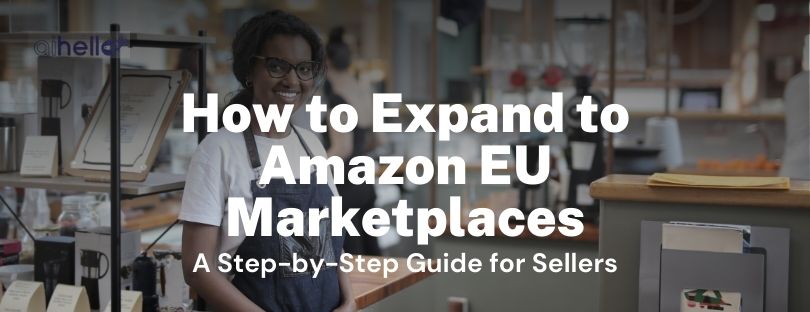Expanding into Amazon’s European marketplaces gives you access to over 500 million potential customers across Germany, the UK, France, Italy, and Spain. In 2023, Amazon’s EU marketplaces reached a gross merchandise value of $201 billion, highlighting the significant growth potential in these markets.
However, selling in Europe comes with challenges like VAT registration, compliance with EU regulations, and localizing product listings to match cultural preferences.
This guide breaks it all down step-by-step, providing the exact information you need to avoid delays, unexpected costs, and account suspensions, so you can confidently launch and succeed in these lucrative marketplaces.
Step 1: Choose the Right EU Marketplace
Each European marketplace has its own set of advantages and challenges. Below is a quick breakdown of the key factors to consider before deciding which one is best for your business:
| Marketplace | Best For | Key Advantages | Challenges |
| Germany (Amazon.de) | Premium, high-quality products | Largest Amazon EU marketplace, high purchasing power | Strict regulations, mandatory German listings |
| United Kingdom (Amazon.co.uk) | Sellers from English-speaking countries | No language barrier, mature e-commerce industry | Post-Brexit customs and VAT complexities, high competition |
| France (Amazon.fr) | Luxury, fashion, beauty, and home goods | Brand-conscious consumers, growing e-commerce sector | Strict advertising rules, mandatory French listings |
| Italy (Amazon.it) | Sellers looking for a fast-growing market with less competition | Less saturated than Germany/UK, strong demand for fashion & home goods | Lower purchasing power in some regions, mandatory Italian listings |
| Spain (Amazon.es) | Sellers targeting price-sensitive shoppers in an emerging market | Lower competition, growing online consumer base | Lower willingness to pay for premium products, mandatory Spanish listings |
| Netherlands (Amazon.nl) | Sellers looking for a tech-savvy audience with lower competition | High internet adoption, familiarity with international brands | Local competitor Bol.com dominates the market |
| Sweden (Amazon.se) | Sellers offering eco-friendly and sustainable products | High e-commerce adoption, low competition | Smaller customer base, sustainability is key |
| Poland (Amazon.pl) | Sellers looking for early-market entry with low ad costs | Growing economy, lower advertising costs | Allegro is the dominant local platform, lower Amazon traffic |
United Kingdom (Amazon.co.uk)
The UK is Amazon’s second-largest European marketplace and one of the easiest for international sellers to enter.
Since English is the primary language, sellers from the U.S., Canada, and Australia can expand here without dealing with translation costs or customer service challenges.
The UK also has a mature e-commerce market, meaning shoppers trust Amazon and buy frequently.
However, post-Brexit trade regulations have made VAT, import duties, and customs clearance more complex. This is why shipping from outside the UK (even within the EU) now involves additional paperwork and costs, so logistics must be well-planned.
Additionally, competition is fierce, especially in popular categories like electronics, home goods, and beauty.
Best for: Sellers already operating in English-speaking markets looking for a high-demand, well-established market.Challenges: Post-Brexit customs regulations, high competition, and VAT complexities.
Germany (Amazon.de)
Germany is Amazon’s biggest and most profitable marketplace in Europe, with annual sales exceeding $37.6 billion.
German consumers prioritize quality and durability, making it a great market for premium products that might struggle in more price-sensitive regions.
However, Germany has strict product compliance laws, particularly for electronics, health-related items, and children’s products.
Additionally, listings must be in German, meaning sellers need high-quality translations to effectively communicate with customers.
While competition is high, it’s more balanced than in the UK, as German shoppers value reputation and long-term product quality over just price.
Best for: Brands selling high-quality, durable products that can invest in compliance and translations.
Challenges: Strict regulations, mandatory German-language listings, and compliance-heavy product categories.
France (Amazon.fr)
France is one of Amazon’s fastest-growing European markets, with strong demand in categories like luxury goods, fashion, beauty, and home decor.
French shoppers care deeply about brand reputation and aesthetics, making this a great market for premium or designer products.
However, France has strict advertising laws, meaning certain promotions and discounts might be restricted.
Additionally, product listings must be in French, so professional translation is required.
While competition is lower here than in Germany and the UK, marketing and branding play a crucial role in success.
Best for: Sellers with premium, high-end products or strong branding who want to target style-conscious consumers.
Challenges: French-language requirements, strict advertising rules, and strong branding expectations.
Italy (Amazon.it)
Italy’s e-commerce sector is expanding quickly, but Amazon isn’t as dominant here as in Germany and the UK. This presents an opportunity for sellers looking for less competition and lower advertising costs.
Italians are increasingly shopping online, and demand is strong for fashion, kitchenware, home essentials, and electronics.
However, Italy’s economic disparities mean that purchasing power varies by region. For example, Northern Italy has stronger demand for premium products, while the South tends to be more price-sensitive.
Additionally, listings must be in Italian, and competition is lower, but conversion rates will suffer without proper listing localization.
Best for: Sellers looking for a fast-growing but less saturated market with opportunities in fashion, home, and lifestyle products.
Challenges: Lower purchasing power in some regions and mandatory Italian-language listings.
Spain (Amazon.es)
Spain is an emerging e-commerce market with less competition than Germany, the UK, and France.
Since online shopping is rapidly growing among Spaniards, there’s an opportunity to establish your brand before competition increases.
However, they’re very price-sensitive, meaning your products must be competitively priced. This also means discounts, promotions, and bundles work extremely well here.
Additionally, listings must be in Spanish, and customer service needs to be localized to improve customer loyalty.
Best for: Sellers with budget-friendly products or those looking for lower competition in an expanding market.
Challenges: Low willingness to pay for premium products and the need for Spanish translations.
The Newer Amazon EU Marketplaces
Beyond the five major EU marketplaces, Amazon has expanded into the Netherlands, Sweden, and Poland. These marketplaces have lower competition but also smaller customer bases.
Netherlands (Amazon.nl) – Strong e-commerce culture, high credit card adoption, and growing demand, but competes with Bol.com, a dominant local player.
Sweden (Amazon.se) – Consumers expect sustainability and eco-friendly products.
Poland (Amazon.pl) – Amazon is not the dominant e-commerce player here (Allegro is), but Poland has low advertising costs and is a growing economy.
Best for: Sellers who want to enter a less competitive market early and establish themselves before growth explodes.
Challenges: Smaller customer bases, language barriers, and local competitors.
Step 2: Assess Product Demand in Your Chosen Marketplace
After selecting the European marketplace that aligns with your business goals, the next step is validating demand for your product in that country.
This ensures that you’re not entering the Amazon EU marketplace blindly but are setting yourself up for success by selling a product that EU customers are actively searching for and buying.
Here’s how to use Helium 10’s X-Ray Chrome extension to determine if your product has strong sales potential before expanding:
Step 1: Go to your chosen EU Amazon marketplace (e.g., Amazon.co.uk).
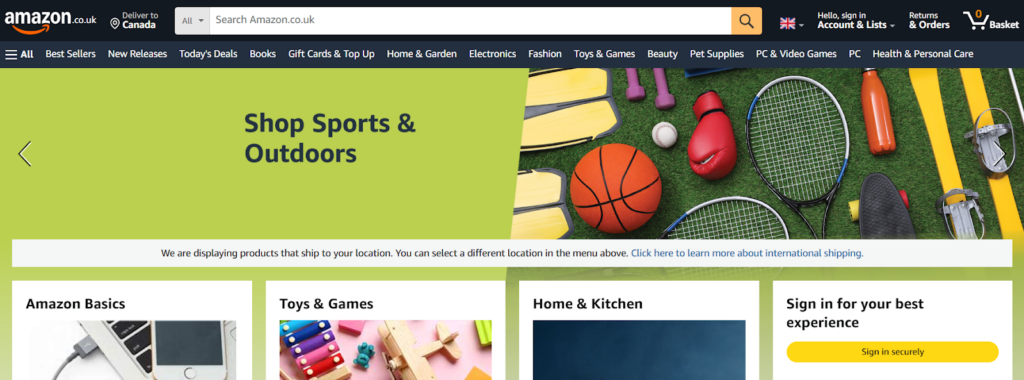
Step 2: Search for your product’s main keyword (e.g., “water resistant backpack”).
Step 3: Select a combination of listings with lots of reviews and high rankings and lower-performing listings that are most similar to yours.
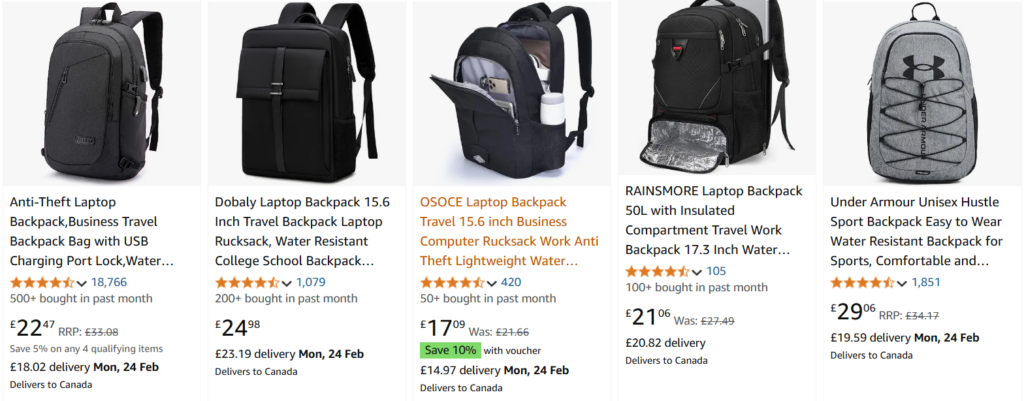
Step 4: Using the X-Ray Chrome extension, look at how many units each competitor sells per month.
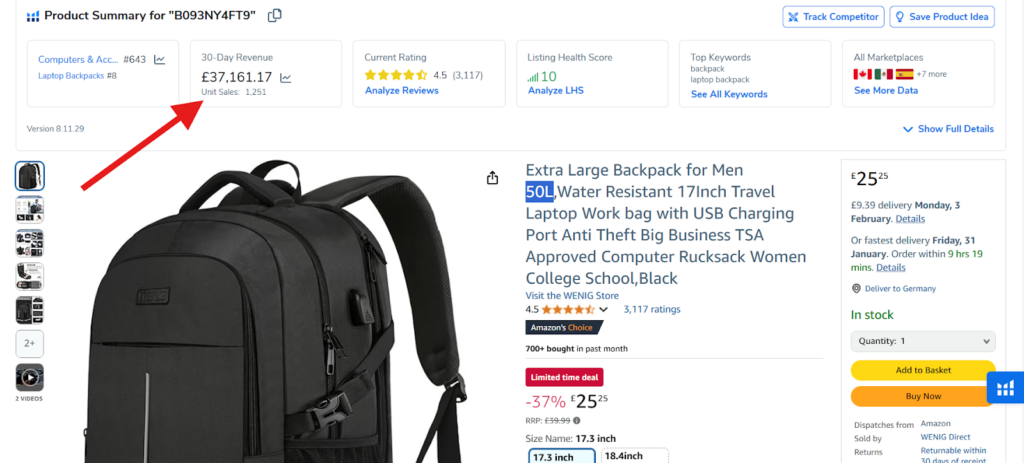
If competitors in your category sell between 500–1,000 units consistently every month, this indicates strong demand. However, if most listings sell fewer than 100 units monthly, it might not be worth pursuing.
Step 3: Set Up Your Amazon Europe Seller Account
After choosing a marketplace and ensuring VAT and compliance readiness, the next thing to do is set up your Amazon EU account correctly.
To make this easier, Amazon offers the European Unified Account, which allows you to manage multiple EU marketplaces from a single interface.
Here’s how to set up your Amazon Europe Seller Account:
Step 1: Access the ‘Sell Globally’ Feature in your Seller Central account

Step 2: Link or Create European Marketplaces
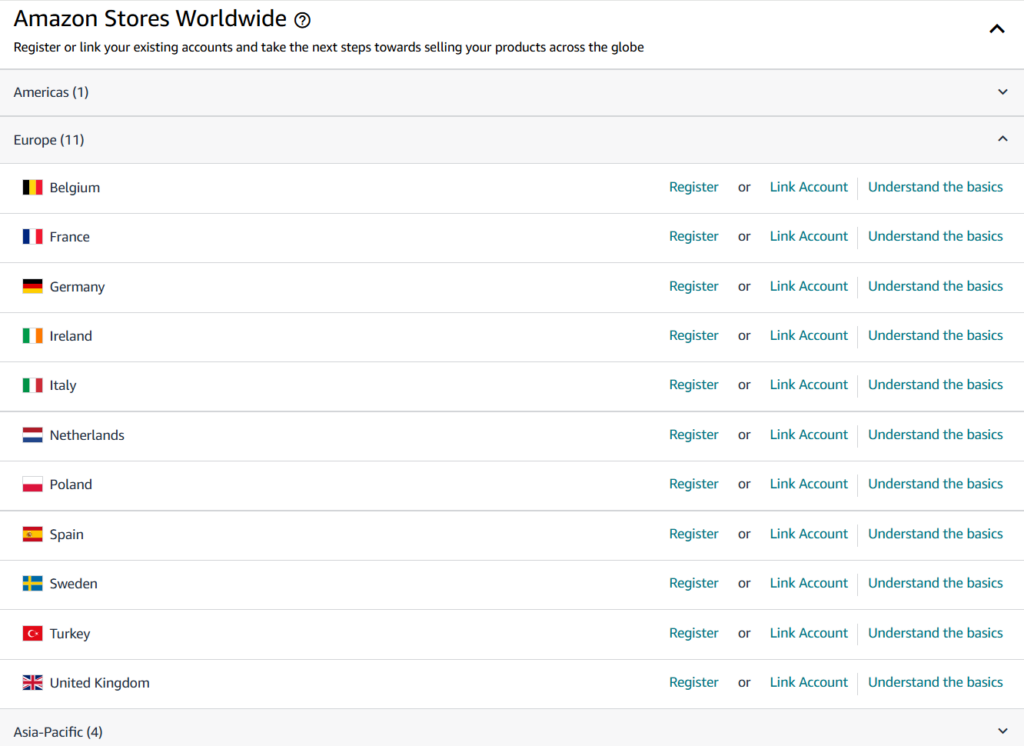
You’ll be guided through the registration process, which may require information such as your business details, identification, and bank account information.
Once set up, your European Unified Account allows you to list products across multiple EU marketplaces, including the UK, Germany, France, Italy, Spain, the Netherlands, Sweden, and Poland.
This means you can manage your listings, inventory, and orders for all these marketplaces from a single Seller Central interface.
Step 4: Understand VAT & Compliance Requirements
Expanding to Amazon’s European marketplaces also means dealing with VAT registration, tax filing, and product compliance laws—all of which differ from country to country. Failure to comply can lead to unexpected costs, listing removals, or even account suspension.
This section breaks down what VAT is, when you need to register, how to stay compliant, and what product safety regulations apply.
What is VAT & How Does It Work for Amazon EU Sellers?
Value Added Tax (VAT) is a consumption tax applied at each stage of the supply chain in every European country. Unlike U.S. sales tax, VAT is included in the final product price displayed to customers.
For example, if you sell a product for €100 in Germany, and Germany’s VAT rate is 19%, the final price to customers is €119. You must remit €19 to the German tax authorities.
When & Where Do You Need to Register for VAT?
You must register for VAT in any EU country where you store inventory (e.g., an Amazon fulfillment center) or sell directly to consumers & exceed the EU-wide distance selling threshold (€10,000 in annual sales across borders).
For example, if you’re storing inventory in Germany for Pan-European FBA, you must register for VAT in Germany plus any other country where Amazon stores your stock.
However, if you only sell via EFN from a UK warehouse, you only need VAT registration in the UK (unless sales exceed €10,000 in another EU country).
Here’s a breakdown of VAT registration requirements based on your chosen fulfillment model:
| Fulfillment Model | Where You Need VAT Registration |
| FBA (One Country Storage Only) | Only in the country where Amazon stores your inventory. |
| European Fulfillment Network (EFN) | Only in one country (where you store inventory). |
| Pan-European FBA | In every country where Amazon stores your inventory (Germany, France, Italy, Spain, Poland, Czech Republic). |
| FBM (Merchant Fulfilled) | In the country where the seller exceeds the €10,000 cross-border sales threshold. |
How to Register & File VAT in the EU
- Determine where your inventory is stored and if your sales exceed the VAT threshold.
- Apply for a VAT number in that country through local tax authorities or an Amazon VAT service.
- Charge VAT on applicable sales and include it in product pricing.
- File VAT returns regularly (monthly or quarterly, depending on country).
Note that Amazon offers VAT Services to assist with registration and filing. You can also use third-party VAT compliance services like Avalara or TaxJar.
Product Compliance and Safety Standards
Beyond VAT, you must also ensure that your products meet the EU’s product safety and environmental regulations as failure to meet compliance standards can lead to listing removals, fines, or customs rejections.
CE Marking
Many products, including electronics and toys, require CE marking to indicate conformity with EU health, safety, and environmental standards.
Additionally, since July 16, 2021, sellers must appoint an EU Responsible Person for CE-marked products, whose contact information must be included on the product, packaging, or accompanying documentation.
Labeling Requirements
Your products must display appropriate labels indicating compliance with EU regulations. This includes information such as product origin, safety warnings, and usage instructions in the local language.
Steps to Ensure Compliance:
- Identify applicable regulations: Determine which EU directives and standards apply to your products.
- Conduct conformity assessments: Test your products to ensure they meet EU requirements.
- Appoint an EU Responsible Person: Designate a representative within the EU for regulatory matters.
- Maintain technical documentation: Keep detailed records proving compliance, as authorities may request them.
Step 5: Plan Your Fulfillment & Logistics Strategy
Amazon offers four primary fulfillment options for EU sellers: Fulfillment by Amazon (FBA), Fulfillment by Merchant (FBM), Amazon’s European Fulfillment Network (EFN), and Pan-European FBA.
| Fulfillment Model | Best For | Key Advantages | Challenges |
| FBA (Local Country Storage Only) | Single-market sellers | Lower VAT obligations | Only ships within one country |
| European Fulfillment Network (EFN) | Testing multiple markets | Stores inventory in one country but ships across Europe | Higher cross-border fees & slower shipping |
| Pan-European FBA | Scaling across multiple EU countries | Faster shipping & lower fulfillment fees | Requires VAT registration in multiple countries |
| FBM | Sellers with an existing fulfillment network | More control over inventory & no FBA storage fees | Longer shipping times & higher per-unit fulfillment costs |
How to Ship Inventory to Amazon’s European Fulfillment Centers
As a seller outside the EU, you need a reliable logistics plan to ship inventory into Amazon’s fulfillment network or a third-party warehouse. Here are the two options available:
Amazon Global Logistics (AGL)
Amazon’s own freight service allows you to ship inventory directly from your supplier to Amazon fulfillment centers in Europe. This option also requires Amazon to handle customs clearance and import VAT.
Third-Party Logistics Providers (3PLs)
Some sellers use DHL, UPS, or regional EU 3PL warehouses for storage and fulfillment instead of FBA. This approach provides more flexibility but requires handling customs and compliance independently.
Handling Customer Service & Returns in the EU
Consumer protection laws are stricter in the EU than in North America, meaning sellers must have a clear plan for handling customer inquiries and product returns to avoid delays and fines.
Amazon automatically handles returns and customer service for FBA orders so FBA sellers do not need to manage return logistics.
However, sellers using FBM or third-party fulfillment must provide a return address in the country of sale or provide pre-paid international return shipping.
Additionally, Amazon enforces a 14-day return period under EU law, though individual marketplaces may have longer return windows. Electronics, apparel, and health-related products may also have additional return requirements.
Step 6: Optimize Your Product Listings for EU Markets
Amazon shoppers in Germany, France, Italy, Spain, and other EU countries have unique expectations, language preferences, and search behaviors, which means simply copying your existing listings from your current marketplace won’t work.
Here’s how to optimize your listings effectively for Amazon EU marketplaces:
1. Translate Listings Correctly
While Amazon provides machine translations through tools like Build International Listings (BIL), these are often literal translations that miss cultural nuances and buyer intent.
Best Practices:
- Use native-speaking translators or Amazon-approved translation services to ensure clarity.
- Adapt descriptions to local phrasing and avoid direct word-for-word translations.
- Ensure units of measurement, currency symbols, and date formats are localized (e.g., cm vs. inches, kg vs. lbs).
2. Optimize Keywords for Each Language
Shoppers in different EU countries search differently, even when looking for the same product. This means a high-ranking keyword in the UK may not be popular in Germany or Spain.
How to Find the Right Keywords:
- Use Helium 10 or JungleScout to conduct keyword research specific to each country.
- Incorporate region-specific synonyms (e.g., a “duvet” in the UK may be called a “couette” in France).
3. Optimize Images & A+ Content for EU Shoppers
Shoppers in different European countries respond to different visual cues. If you’re using the same U.S. images in Germany or Spain, you may miss out on conversions because they don’t feel localized.
Best Practices for Product Images in EU Markets:
- Use region-specific lifestyle images (e.g., a French kitchen for a cookware product in Amazon.fr).
- Adjust measurement units (e.g., “30 cm x 20 cm” for Europe instead of “12 in x 8 in”).
- Use captions in the correct language (avoid English text in an image for Amazon.de).
- Ensure packaging images match local compliance standards (CE markings, eco-labels, etc.).
Additionally, Amazon’s Premium A+ Content lets you add country-specific variations, so use this feature to show localized infographics, instructions, and lifestyle photos.
Conclusion
Expanding to Amazon’s European marketplaces unlocks a massive new customer base and revenue potential, but navigating VAT, compliance, fulfillment, and localization can slow you down.
Now, with a clear roadmap for choosing the right marketplace, setting up fulfillment, ensuring VAT compliance, and optimizing listings, you have everything needed to launch smoothly and scale successfully in the EU.
